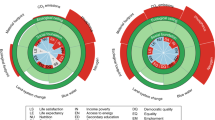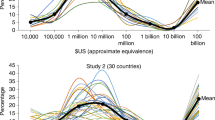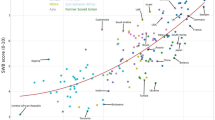Abstract
Humanity faces the challenge of how to achieve a high quality of life for over 7 billion people without destabilizing critical planetary processes. Using indicators designed to measure a ‘safe and just’ development space, we quantify the resource use associated with meeting basic human needs, and compare this to downscaled planetary boundaries for over 150 nations. We find that no country meets basic needs for its citizens at a globally sustainable level of resource use. Physical needs such as nutrition, sanitation, access to electricity and the elimination of extreme poverty could likely be met for all people without transgressing planetary boundaries. However, the universal achievement of more qualitative goals (for example, high life satisfaction) would require a level of resource use that is 2–6 times the sustainable level, based on current relationships. Strategies to improve physical and social provisioning systems, with a focus on sufficiency and equity, have the potential to move nations towards sustainability, but the challenge remains substantial.
This is a preview of subscription content, access via your institution
Access options
Access Nature and 54 other Nature Portfolio journals
Get Nature+, our best-value online-access subscription
$29.99 / 30 days
cancel any time
Subscribe to this journal
Receive 12 digital issues and online access to articles
$119.00 per year
only $9.92 per issue
Buy this article
- Purchase on Springer Link
- Instant access to full article PDF
Prices may be subject to local taxes which are calculated during checkout




Similar content being viewed by others
References
Raworth, K. A Safe and Just Space for Humanity: Can We Live Within the Doughnut? (Oxfam, Oxford, UK, 2012).
Raworth, K. Doughnut Economics: Seven Ways to Think Like a 21st-Century Economist (Random House, London, 2017).
Steffen, W. et al. Planetary boundaries: guiding human development on a changing planet. Science 347, 1259855 (2015).
Rockström, J. et al. A safe operating space for humanity. Nature 461, 472–475 (2009).
Hoekstra, A. Y. & Wiedmann, T. O. Humanity’s unsustainable environmental footprint. Science 344, 1114–1117 (2014).
Fang, K., Heijungs, R. & De Snoo, G. R. Understanding the complementary linkages between environmental footprints and planetary boundaries in a footprint-boundary environmental sustainability assessment framework. Ecol. Econ. 114, 218–226 (2015).
Sandin, G., Peters, G. M. & Svanström, M. Using the planetary boundaries framework for setting impact-reduction targets in LCA contexts. Int. J. Life Cycle Assess. 20, 1684–1700 (2015).
Häyhä, T., Lucas, P. L., van Vuuren, D. P., Cornell, S. E. & Hoff, H. From planetary boundaries to national fair shares of the global safe operating space—how can the scales be bridged? Glob. Environ. Chang. 40, 60–72 (2016).
Nykvist, B. et al. National Environmental Performance on Planetary Boundaries. (Swedish Environmental Protection Agency, Stockholm, 2013).
Dao, H. et al. Environmental Limits and Swiss Footprints Based on Planetary Boundaries. (UNEP/GRID-Geneva and University of Geneva, Geneva, 2015).
Hoff, H., Nykvist, B. & Carson, M. Living Well, Within the Limits of Our Planet? Measuring Europe’s Growing External Footprint (Stockholm Environment Institute, Sweden, 2014).
Cole, M. J., Bailey, R. M. & New, M. G. Tracking sustainable development with a national barometer for South Africa using a downscaled “safe and just space” framework. Proc. Natl. Acad. Sci. USA 111, E4399–E4408 (2014).
Dearing, J. A. et al. Safe and just operating spaces for regional social-ecological systems. Glob. Environ. Chang. 28, 227–238 (2014).
Baer, P. The greenhouse development rights framework for global burden sharing: reflection on principles and prospects. Wiley Interdiscip. Rev. Clim. Chang. 4, 61–71 (2013).
D’Alisa, G., Demaria, F. & Kallis, G. Degrowth: A Vocabulary for a New Era (Routledge, New York, 2014).
Hoekstra, A. Y., Mekonnen, M. M., Chapagain, A. K., Mathews, R. E. & Richter, B. D. Global monthly water scarcity: blue water footprints versus blue water availability. PLoS. ONE 7, e32688 (2012).
Lenzen, M., Murray, J., Sack, F. & Wiedmann, T. Shared producer and consumer responsibility: theory and practice. Ecol. Econ. 61, 27–42 (2007).
Max-Neef, M. Human-Scale Development: Conception, Application and Further Reflections (Apex, London, 1991).
Doyal, L. & Gough, I. A Theory of Human Need (Macmillan, Basingstoke, UK, 1991).
Gough, I. Climate change and sustainable welfare: the centrality of human needs. Cambr. J. Econ. 39, 1191–1214 (2015).
United Nations Transforming Our World: The 2030 Agenda for Sustainable Development (United Nations, 2015).
Daly, H. E. Allocation, distribution, and scale: towards an economics that is efficient, just, and sustainable. Ecol. Econ. 6, 185–193 (1992).
Ekins, P., Simon, S., Deutsch, L., Folke, C. & De Groot, R. A framework for the practical application of the concepts of critical natural capital and strong sustainability. Ecol. Econ. 44, 165–185 (2003).
Daly, H. E. Toward a Steady-State Economy (W.H. Freeman, San Francisco, 1973).
Meadows, D. H. Indicators and Information Systems for Sustainable Development: A Report to the Balaton Group. (The Sustainability Institute, Hartland, VT, 1998).
Fanning, A. L. & O’Neill, D. W. Tracking resource use relative to planetary boundaries in a steady-state framework: a case study of Canada and Spain. Ecol. Indic. 69, 836–849 (2016).
O’Neill, D. W. The proximity of nations to a socially sustainable steady-state economy. J. Clean. Prod. 108, 1213–1231 (2015). Part A.
Meadows, D. Leverage points: places to intervene in a system. Solutions 1, 41–49 (2009).
Cullen, J. M., Allwood, J. M. & Borgstein, E. H. Reducing energy demand: what are the practical limits? Environ. Sci. Technol. 45, 1711–1718 (2011).
Jo, T.-H. Social provisioning process and socio-economic modeling. Am. J. Econ. Sociol. 70, 1094–1116 (2011).
Brand-Correa, L. I. & Steinberger, J. K. A framework for decoupling human need satisfaction from energy use. Ecol. Econ. 141, 43–52 (2017).
Steinberger, J. K. & Roberts, J. T. From constraint to sufficiency: the decoupling of energy and carbon from human needs, 1975–2005. Ecol. Econ. 70, 425–433 (2010).
Lamb, W. F. & Rao, N. D. Human development in a climate-constrained world: what the past says about the future. Glob. Environ. Chang. 33, 14–22 (2015).
Knight, K. W. & Rosa, E. A. The environmental efficiency of well-being: a cross-national analysis. Soc. Sci. Res. 40, 931–949 (2011).
Hoornweg, D., Hosseini, M., Kennedy, C. & Behdadi, A. An urban approach to planetary boundaries. Ambio 45, 567–580 (2016).
Kastner, T., Erb, K.-H. & Haberl, H. Global human appropriation of net primary production for biomass consumption in the European Union, 1986–2007. J. Ind. Ecol. 19, 825–836 (2015).
Running, S. W. A measurable planetary boundary for the biosphere. Science 337, 1458–1459 (2012).
Costanza, R. et al. Quality of life: an approach integrating opportunities, human needs, and subjective well-being. Ecol. Econ. 61, 267–276 (2007).
O’Neill, J. Citizenship, well-being and sustainability: Epicurus or Aristotle? Anal. Krit. 28, 158–172 (2006).
Haberl, H. et al. Natural and socioeconomic determinants of the embodied human appropriation of net primary production and its relation to other resource use indicators. Ecol. Indic. 23, 222–231 (2012).
United Nations World Population Prospects: The 2015 Revision, DVD Edition (Population Division, Department of Economic and Social Affairs, United Nations, 2015).
Princen, T. The Logic of Sufficiency (MIT Press, Cambridge, MA, 2005).
Costanza, R. et al. Time to leave GDP behind. Nature 505, 283–285 (2014).
Dietz, R. & O’Neill, D. W. Enough Is Enough: Building a Sustainable Economy in a World of Finite Resources (Berrett-Koehler, San Francisco, 2013).
Clarke, L. et al. in Climate Change 2014: Mitigation of Climate Change (eds Edenhofer, O. et al.) 413–510 (IPCC, Cambridge Univ. Press, Cambridge, UK, 2014).
Creutzig, F. et al. The underestimated potential of solar energy to mitigate climate change. Nat. Energy 2, 17140 (2017).
McGlade, C. & Ekins, P. The geographical distribution of fossil fuels unused when limiting global warming to 2 °C. Nature 517, 187–190 (2015).
Polimeni, J. M., Mayumi, K., Giampietro, M. & Alcott, B. The Jevons Paradox and the Myth of Resource Efficiency Improvements (Earthscan, London, 2008).
Helliwell, J. F., Layard, R. & Sachs, J. World Happiness Report 2015 (Sustainable Development Solutions Network, 2015).
Wilkinson, R. & Pickett, K. The Spirit Level: Why More Equal Societies Almost Always Do Better (Allen Lane, London, 2009).
Grasso, M. Sharing the emission budget. Polit. Stud. 60, 668–686 (2012).
Gallup International Association Voice of the People Millennium Survey, 2000 (Inter-university Consortium for Political and Social Research [distributor], 2009); https://doi.org/10.3886/ICPSR24661.v1
Lenzen, M., Kanemoto, K., Moran, D. & Geschke, A. Mapping the structure of the world economy. Environ. Sci. Technol. 46, 8374–8381 (2012).
Lenzen, M., Moran, D., Kanemoto, K. & Geschke, A. Building Eora: a global multi-regional input-output database at high country and sector resolution. Econ. Sys. Res. 25, 20–49 (2013).
Burnham, K. P. & Anderson, D. R. Model Selection and Multimodel Inference: A Practical Information-Theoretic Approach 2nd edn (Springer, New York, 2002).
World Bank World Development Indicators (World Bank, 2015); http://data.worldbank.org/.
Acknowledgements
We thank T. Kastner for providing the eHANPP data used in the analysis, and H. Haberl for his thoughts on the eHANPP results. We are grateful to A. Gouldson, K. Raworth and P. Victor for their helpful comments, and the Barcelona Degrowth Reading Group for further suggestions. D.W.O. was supported by an International Academic Fellowship from the Leverhulme Trust, which permitted research visits at the Centre for Global Studies (University of Victoria) and Institut de Ciència i Tecnologia Ambientals (Universitat Autònoma de Barcelona). A.L.F. was supported by the European Union's Horizon 2020 research and innovation programme under Marie Skłodowska-Curie grant agreement No. 752358, while J.K.S. was supported by a Leverhulme Research Leadership Award on 'Living Well Within Limits'.
Author information
Authors and Affiliations
Contributions
D.W.O. designed the study. D.W.O., A.L.F, W.F.L. and J.K.S. assembled the data, performed the analysis and wrote the manuscript.
Corresponding author
Ethics declarations
Competing interests
The authors declare no competing financial interests.
Additional information
Publisher's note: Springer Nature remains neutral with regard to jurisdictional claims in published maps and institutional affiliations.
Supplementary information
Supplementary Information
The theoretical framework (text), Supplementary References 1–92, Supplementary Figures 1–3, Supplementary Tables 1–5.
Supplementary Data
Country-level data for the 7 biophysical and 11 social indicators analysed in the Article.
Rights and permissions
About this article
Cite this article
O’Neill, D.W., Fanning, A.L., Lamb, W.F. et al. A good life for all within planetary boundaries. Nat Sustain 1, 88–95 (2018). https://doi.org/10.1038/s41893-018-0021-4
Received:
Accepted:
Published:
Issue Date:
DOI: https://doi.org/10.1038/s41893-018-0021-4
This article is cited by
-
RASMI: Global ranges of building material intensities differentiated by region, structure, and function
Scientific Data (2024)
-
Where global crop yields may falter next
Nature Food (2024)
-
Forecasting the ecological footprint of G20 countries in the next 30 years
Scientific Reports (2024)
-
Half of twenty-first century global irrigation expansion has been in water-stressed regions
Nature Water (2024)
-
Global river economic belts can become more sustainable by considering economic and ecological processes
Communications Earth & Environment (2024)



